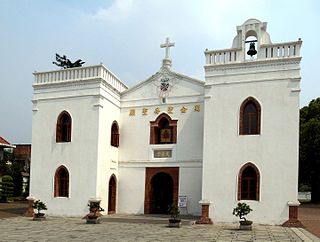
The practice of Christianity in Korea is marginal in North Korea, but significant in South Korea, where it revolves around Protestantism and Catholicism, accounting for 8.6 million and 5.8 million members, respectively. Christianity in the form of Catholicism was first introduced during the late Joseon Dynasty period by Confucian scholars who encountered it in China. In 1603, Yi Su-gwang, a Korean politician, returned from Beijing carrying several theological books written by Matteo Ricci, an Italian Jesuit missionary to China. He began disseminating the information in the books, introducing Christianity to Korea. In 1787, King Jeongjo of Joseon officially outlawed Catholicism as an "evil practice," declaring it heretical and strictly banned. Catholicism was reintroduced in 1785 by Yi Seung-hun and French and Chinese Catholic priests were soon invited by the Korean Christians.

Christianity has been present in China since the early medieval period, and became a significant presence in the country during the early modern era. The Church of the East appeared in China in the 7th century, during the Tang dynasty. Catholicism was one of the religions patronized by the emperors of the Mongol-led Yuan dynasty, but it did not take root in China until its reintroduction by the Jesuits during the 16th century. Beginning in the early 19th century, Protestant missions in China attracted small but influential followings, and independent Chinese churches were also established.
Protestant Christianity entered China in the early 19th century, taking root in a significant way during the Qing dynasty. Some historians consider the Taiping Rebellion to have been influenced by Protestant teachings. Since the mid-20th century, there has been an increase in the number of Christian practitioners in China. According to a survey published in 2010 there are approximately 40 million Protestants in China. As of 2019, Fenggang Yang, a sociologist of religion at Purdue University, estimated that there are around 100 million Protestant Christians in China. Other estimates place the number of Protestant Christians at around 40–60 million

In the early 19th century, Western colonial expansion occurred at the same time as an evangelical revival – the Second Great Awakening – throughout the English-speaking world, leading to more overseas missionary activity. The nineteenth century became known as the Great Century of modern religious missions.
International Ministries is an international Baptist Christian missionary society. It is a constituent board affiliated with the American Baptist Churches USA. The headquarters is in King of Prussia, Pennsylvania, United States.
The Protestant Episcopal Church Mission was a Christian missionary initiative of the Episcopal Church that was involved in sending and providing financial support to lay and ordained mission workers in growing population centers in the west of the United States as well as overseas in China, Liberia and Japan during the second half of the 19th Century.
American Reformed Mission was an American Protestant Christian missionary society of the Dutch Reformed Church, that was involved in sending workers to countries such as China during the late Qing Dynasty.
American Southern Methodist Episcopal Mission was an American Methodist missionary society operated by the Methodist Episcopal Church, South that was involved in training and sending workers to urban centers in the U.S. as well as to other countries. The Board of Foreign Missions approved those missionaries who were sent to work in evangelical projects. Missions began in China during the late Qing Dynasty.
American Southern Presbyterian Mission was an American Presbyterian missionary society of the Southern Presbyterian Church that was involved in sending workers to countries such as China during the late Qing Dynasty, Japan and Korea. It was organized in 1862.
English Presbyterian Mission was a British Presbyterian missionary society that was involved in sending workers to countries such as China during the late Qing Dynasty.
The English Wesleyan Mission was a British Methodist missionary society that was involved in sending workers to countries such as New Zealand and China in the 19th century.
General Evangelical Protestant Mission later the East Asian Mission was a German Protestant Christian missionary society that was involved in sending workers to countries such as China during the late Qing Dynasty.
The Irish Presbyterian Mission was an Irish Presbyterian missionary society.
Seventh Day Baptist Missionary Society is a Baptist missionary society that was involved in sending workers to countries such as China as far back as the late Qing dynasty. It was organized in 1842 by Seventh Day Baptists and is still active in promoting the gospel of Jesus around the world.
Scottish United Presbyterian Mission was a Scottish Presbyterian missionary society that was involved in sending workers to countries such as China during the late Qing dynasty.
The Church of Christ in China was a coalition of churches in mainland China, established in the early half of the twentieth century. After missionaries were expelled from China in the 1950s, it would continue to exist primarily in the Hong Kong Council of the Church of Christ in China.
Characteristic of Christianity in the 19th century were evangelical revivals in some largely Protestant countries and later the effects of modern biblical scholarship on the churches. Liberal or modernist theology was one consequence of this. In Europe, the Roman Catholic Church strongly opposed liberalism and culture wars launched in Germany, Italy, Belgium and France. It strongly emphasized personal piety. In Europe there was a general move away from religious observance and belief in Christian teachings and a move towards secularism. In Protestantism, pietistic revivals were common.

Christianity is a minority religion in the southwestern Chinese province of Sichuan. The Eastern Lipo, Kadu people and A-Hmao are ethnic groups present in the province.

Christianity in Taiwan constituted 3.9% of the population, according to Taiwan's 2005 census. Christians on the island included approximately 600,000 Protestants, 300,000 Catholics and a small number of members of the Church of Jesus Christ of Latter-day Saints. Estimates in 2020 suggested that the portion had risen to 4% or 6%.



